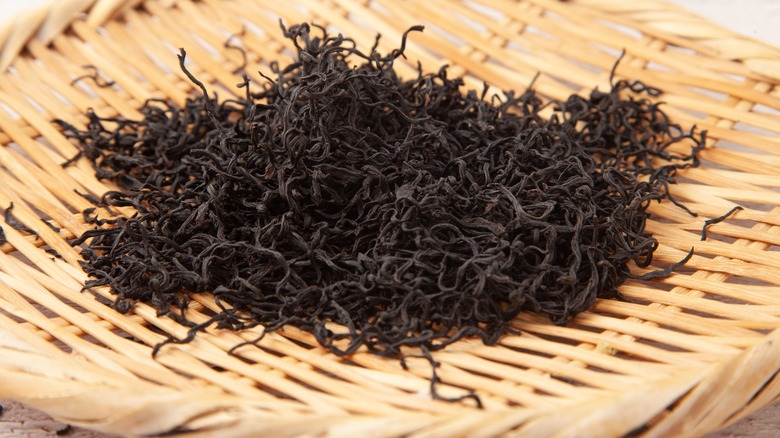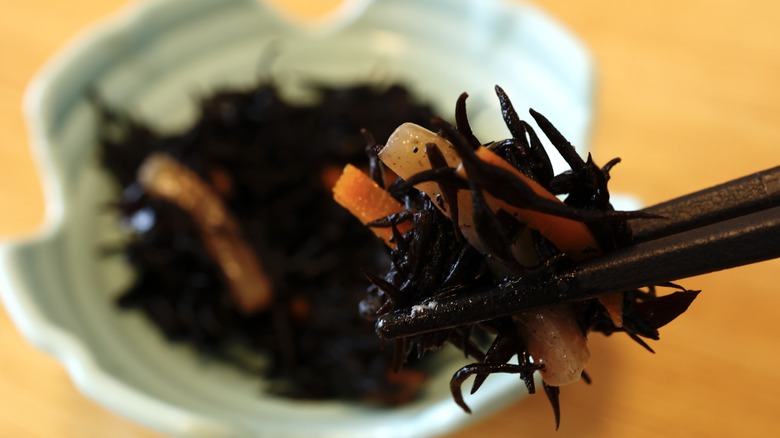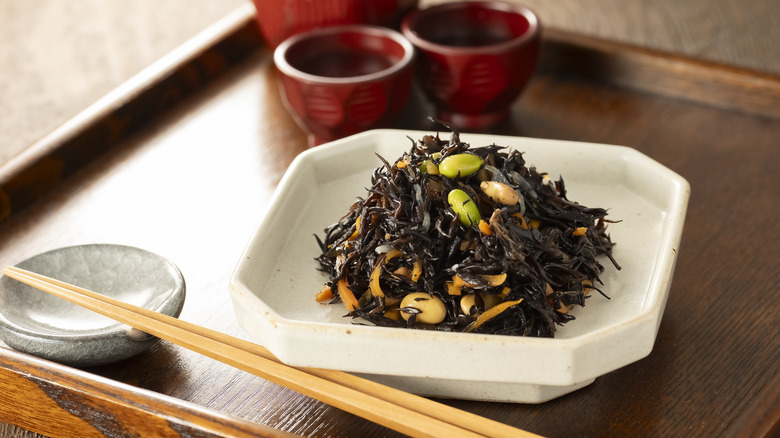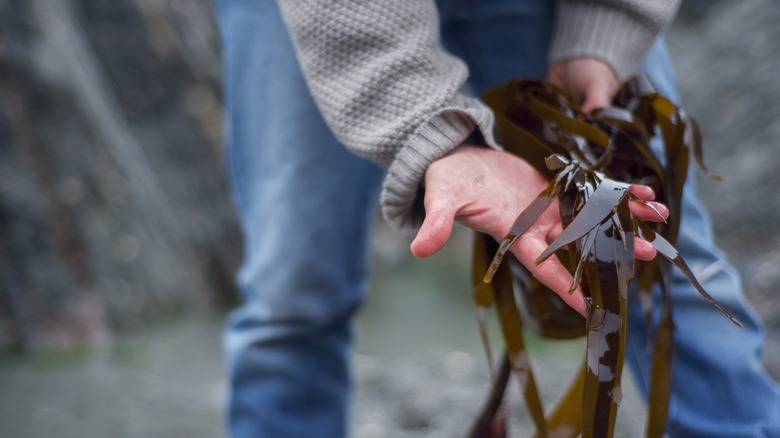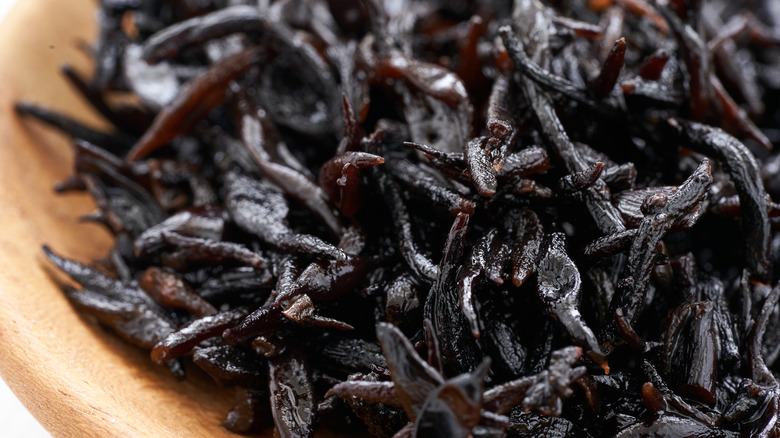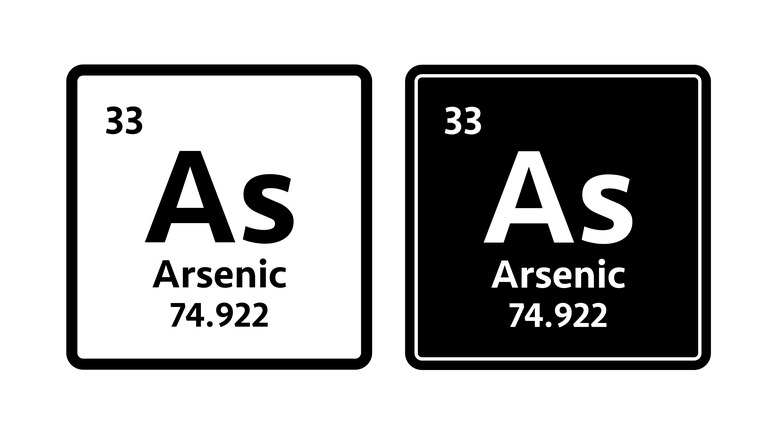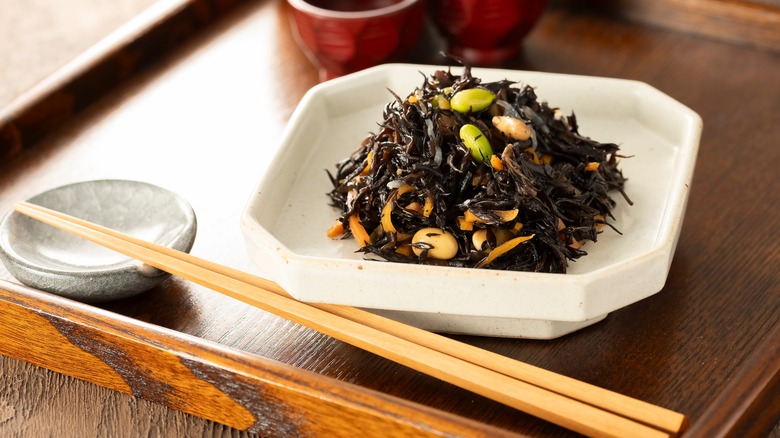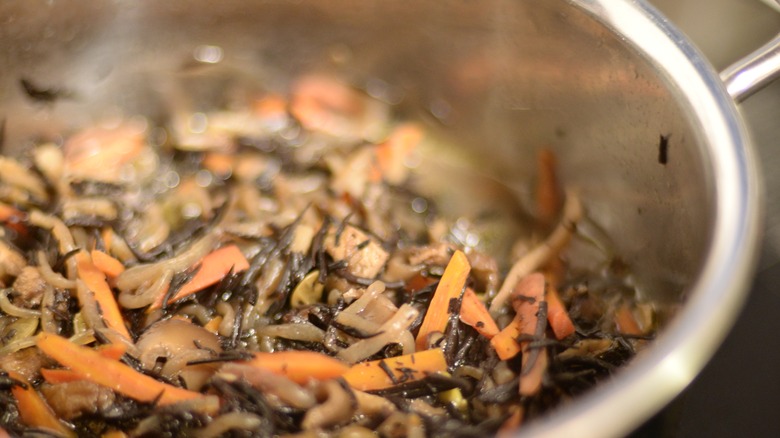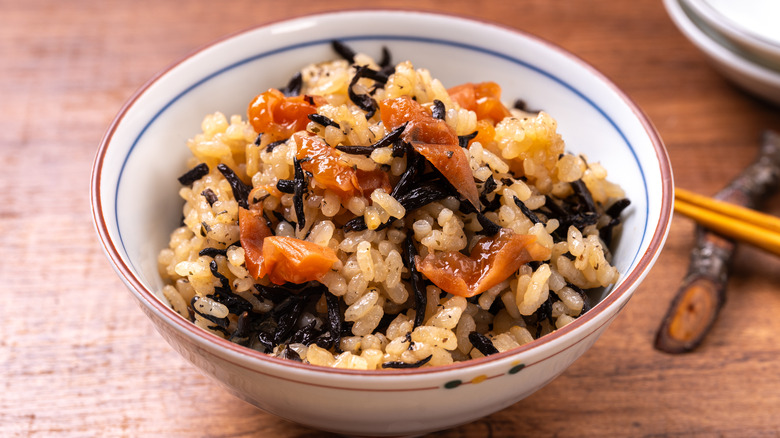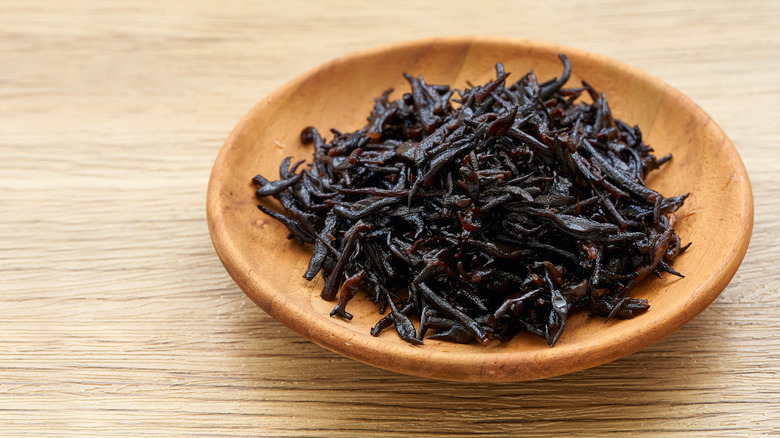What Is Hijiki Seaweed And Is It Actually Dangerous To Eat?
Did you know there are more than 10,000 varieties of seaweed? While you may recognize nori (often featured in sushi rolls) or furikake (the ground up seafood sprinkled on top of rice dishes), hijiki seaweed holds a special place in the hearts of Japanese people (via Umami Insider). This unique seaweed variety not only imparts an umami flavor to numerous dishes but also brings a substantial dose of nourishing benefits. However, a quick internet search will reveal warnings about hijiki, as it may pose dangers of elevated arsenic levels.
Despite these potential risks, hijiki has been a staple in Japanese cuisine for centuries. While it has yet to gain widespread popularity in the Western culinary scene, acquiring and exploring the flavors of this seaweed is relatively straightforward. Prepare to delve into the wonders (and potential dangers) of this unique ingredient, and you might find yourself heading to your local Japanese market for a firsthand experience.
So what exactly is hijiki?
Hijiki is a type of wild seaweed primarily found along the coasts of Japan, Korea, and China (via Kim'C Market). While relatively unfamiliar in the United States, this seaweed has been a culinary staple in its native countries for centuries. Growing beneath the ocean surface, the seaweed exhibits a dark green, almost brownish color. Through the harvesting process, it transforms into a dark black shade, and its leaves shrink as they dry, ultimately resembling something that could be mistaken for tea leaves. Hijiki is commonly used in salads, as a addition to rice dishes, and beyond.
Hijiki consists of two distinct parts: Nagahijiki and Mehijiki. Nagahijiki constitutes the stem portion of the plant, offering a crisp texture. Mehijiki is the leaf section, providing a softer feel. Mehijiki is most commonly used in cooking, adding a unique touch to various dishes with its delicate texture and rich flavor profile.
The history of hijiki
Many millennia ago, Japanese people faced a calcium deficiency in their diet due to soil limitations, prompting them to incorporate seaweed as a rich source of this vital nutrient. This dietary practice is believed to have originated around 100-200 AC (per Kurakon USA). The earliest documented recipe featuring hijiki is found in a cookbook dating back to 1643 AC, featuring a salad recipe that continues to be a prevalent and enduring culinary tradition today. According to Japanese folklore, the seaweed even has properties that can bolster personal beauty, with some people consuming it regularly to support hair health (per Japan Talk). This theory may have some truth behind it, as hijiki is high in iron, and iron deficiency can cause hair loss.
Presently, hijiki is still harvested — often by hand — in Japan and various other Asian countries. This practice reflects a longstanding tradition of integrating nutritious seaweed into daily cuisine. Hijiki has become increasingly accessible in Japanese grocery stores and through online shopping, particularly in regions such as North America.
The harvesting process
The Ise and Boshu methods are the two main techniques for harvesting Hijiki rooted in Japanese tradition. The Ise method — the more prevalent of the two — involves sun-drying the hijiki at the harvest site. Subsequently, the seaweed is transported to a processing site for cleaning. Finally, the hijiki is steamed (to help reduce any bitterness) and left to dry — after which it is ready for sale. The less common Boshu method results in a stronger salt flavor. Following the initial harvest, the hijiki undergoes heating through boiling or steaming, followed by sun-drying or it's dried by a machine.
Harvesting hijiki is a long-standing tradition in Japan, with a dedicated festival in Okinawa where locals come together to cultivate this nourishing crop. As one Japanese local notes, "Hijiki doesn't grow well in many places on Okinawa, but on the beach of Camp Courtney, it's bountiful. Camp Courtney has the Hijiki Festival once per year, and my mother and I are extremely grateful to be able to access the beach for the harvest." (via Okinawa Marines)
Is it safe to eat?
If you come across information about hijiki, you might encounter concerns regarding its potential hazards when consumed. This is because hijiki tends to absorb elevated levels of arsenic, a heavy metal present in seawater, which can be toxic in large quantities. Excessive exposure to foods containing arsenic has been associated with a variety of serious diseases, including cancer. In 2004, the U.K. Food Standards Agency issued a warning against consuming hijiki (via the Regulatory Toxicology and Pharmacology journal). However, the Japanese Ministry has advised that hijiki can be safely consumed, as long as it's less than 4.7 grams per day.
When enjoyed in moderation, hijiki provides a rich array of fiber and minerals considered beneficial for the body. We recommend conducting your own research before deciding to try hijiki, but it's worth noting that many people worldwide have safely made hijiki a part of their diet.
All about arsenic
Arsenic naturally occurs in the earth's crust and is found in small quantities in the air, rocks, water, and soil. It exists in both organic and inorganic forms within various foods — however, the inorganic form poses the threat of toxicity (via the Centre for Food Safety). People are most often exposed to arsenic through the consumption of foods, particularly seafoods that tend to contain higher arsenic exposure from growing in water. Foods that often contain arsenic include seafood, rice, mushrooms, and poultry. People can also be exposed to arsenic via water consumption. High levels of arsenic can be found in the drinking water in countries like China, Taiwan, Bangladesh, some areas of the United States. It is most commonly found in water that comes from ground sources, such as a well (per American Cancer Society).
Elevated exposure to inorganic arsenic has been linked to gastrointestinal effects, cancer, and other serious illnesses. It is important to do your own research to help make informed decisions when it comes to consuming food that has been exposed to arsenic.
What are the benefits of consuming hijiki?
After learning about the potential of elevated arsenic levels, you might question why you'd even consider trying this seaweed. However, there are numerous reasons why this sea vegetable has been cherished in Japan and other Asian countries for centuries. When consumed in moderation, hijiki offers a wealth of nourishing benefits. To begin with, it is naturally high in fiber, vitamin K, calcium, iron, and magnesium (along with many other vitamins and minerals). Similar to other vegetables, this fibrous seaweed promotes digestive health. The presence of magnesium can also contribute to preparing your body for a restful night of sleep. Additionally, it is low in calories and imparts a delightful umami flavor when enjoyed as a salad or topping.
Hijiki presents a delectably mushroom-like umami flavor, described as "earthy — less salt and more loamy minerality. Hijiki has a less pronounced brininess than other types of seaweed like nori, wakame, and kombu" (via MasterClass). The nourishing benefits and unique flavor can easily outweigh the risks, when consumed responsibly.
How to cook with hijiki
Hijiki offers remarkable versatility in its culinary applications. You can discover recipes featuring it as an add-on to bento boxes, the primary ingredient in salads, or a complementary element in various asian inspired dishes. Between the two types of hijiki, nagahijiki and mehijiki, the latter is more prevalent in recipes due to its softer texture and milder flavor, which makes it easier to cook with. When working with hijiki, you will need to rehydrate it in water for about 30 minutes before incorporating it into any recipe.
Before rehydrating, the leaves will look like black tea leaves. However, once they absorb water, they will double or triple in size and morph into their true seaweed like nature. Once rehydrated, you are ready to get cooking. Whether you're whipping up a salad, scrambled eggs, or even spaghetti, incorporating hijiki will add a boost of nutrients and a distinctive flavor.
Dishes that feature this seaweed
While there are many recipes to discover that incorporate hijiki seaweed, one of the most traditional approaches is a salad. The customary hijiki salad known as "Hijiki no Nimono," celebrates the delightful contrast of umami with sweetness, bringing together vibrant ingredients like edamame beans and carrots. This creates a flavorful salad that stands on its own or serves as a perfect side dish to sushi or another protein. Additionally, hijiki can be a unique ingredient to enhance simple recipes. For instance, you can include it in Japanese fried rice or rice balls. Rice-based dishes are an excellent entry point to incorporate the world of seaweed into your cuisine, providing the ideal hint of salty goodness to this comforting base. Lastly, you can also whip up delicious tofu hijiki hamburgers for a great vegetarian dish. Simply add a bit of hijiki to your go-to tofu patty mixture before frying up on the grill.
While hijiki is most traditionally served in Japanese cuisine, why not mix it up by fusing it into other dishes. What would it taste like in scrambled eggs or in a salty spaghetti drizzled with olive oil? Incorporate rehydrated hijiki into eggs for a fun asian twist on this classic breakfast dish. For a zesty spaghetti, add the seaweed and noodles in a frying pan, along with some garlic, olive oil, and a touch of soy sauce for an addictively tasty dish.
Where to buy hijiki and how to store it
Hijiki is commonly available in dried and shredded form, and you can probably locate it at a Japanese supermarket if you are fortunate enough to have one nearby. Alternatively, you can find it for sale online. Hijiki will last for months while dried and in its packaging, as long as it's stored in a cool dry place. Depending on what types of recipes you cook with it, it will last in the fridge for up to a week. You can also find great make-ahead stir-fry recipes and rice dishes with hijki that can be frozen for longer periods of time. Martha Stewart even has a process for preparing and storing seaweed, although her go-type type of seaweed is kombu.
If you have a taste for seaweed from recent sushi dinners and are interested in elevating your home cooking, we highly recommend heading to your local grocery store or ordering a pack of this dried seaweed. A trip to Japanese market will be sure to introduce you to many other wonderful ingredients celebrated in Japanese cuisine. Once rehydrated, hijki is exceptionally easy to cook with and will introduce a new and exciting flavor to satisfy your taste buds.

